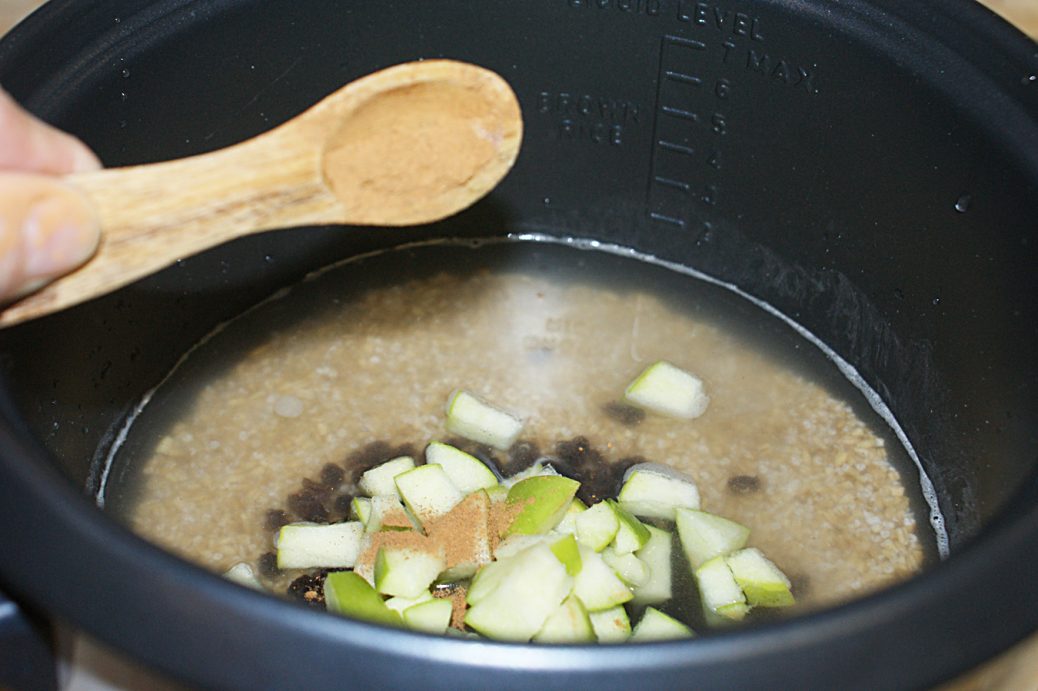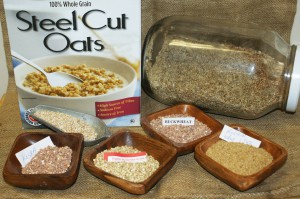By Linda Gabris
Grains are a rich source of protein, fiber, vitamins, minerals, and other nutrients that are vital for good health and well-being. Diets rich in grains help prevent strokes and chronic ailments. When thinking along the lines of good health, it’s always wise to buy organically-grown grains.
Keeping your pantry well-stocked with various grains ensures your family will never go hungry. If you store your grains in a cool, dry place in an airtight container, they will save indefinitely. When grains are cooked, they absorb their cooking liquid and swell up to three or four times their original size; a small handful of grain really does make a lot more than you think.
Basic stovetop cooking directions for grains
You can use the tips below for cooking all types of grains on the stove:
- Rinse the raw grain in a sieve under cold running water and drain well. This removes dirt and dust and rinses away some of the excess starch while kick-starting the swelling process.
- Bring the suggested amount of cooking liquid to a boil in a pot with a tight-fitting lid. I prefer to use a cast iron Dutch oven, but any heavy-bottomed pot will work well. I typically use three parts cooking liquid to one part of grain for bigger, harder grains like wheat, rye, spelt, and barley, and two parts cooking liquid to one part grain for softer, smaller grains like millet and quinoa.
- If making a hot breakfast porridge or dessert out of grain, you can add the uncooked grain directly to the cold cooking liquid which will produce a creamier consistency, otherwise add grain to rapidly boiling water.
- Add rinsed grain to the liquid and give it one good stir. Keep in mind that too much stirring can produce a “gummy” grain, so a gentle stir a couple times during cooking is all that’s needed.
- Allow the pot to come to a boil, put on the lid, reduce heat, and simmer until grain is tender and liquid absorbed. Times will vary depending on the grain. Hard grains like wheat berries and rye kernels can take 40-60 minutes, while softer grains like millet and quinoa will take 15-20 minutes.
- If the grain is too hard after all the cooking liquid has been absorbed, you can add more water or other liquid as needed to finish the cooking process. If the grain is too soft, you can drain it through a sieve and then “dry off” the grain by returning it to the pan and stirring gently with a wooden spoon over low heat until any excess liquid is evaporated.
A properly-cooked kernel of grain should be tender and delightfully chewy. - If you want a nice toasted flavor, try Grandma’s old trick of roasting the grain in a heavy cast iron skillet over medium heat until lightly golden. This produces a nuttier flavor and richer color while speeding up the cooking time a little. It also makes it easier to “crack” the grain should you wish to grind it for a particular recipe.
Cooking grains in other ways
Rice cooker
A modern way to cook grain is to use an electric rice cooker. Simply use grain in place of rice, and follow your manufacturer’s directions for use. Vegetables, herbs, and seasonings can be added directly to the pot along with the uncooked grain.
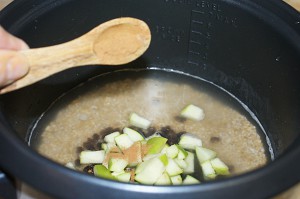
A rice cooker works well for cooking grains.
Thermos method
Another interesting way to cook grain is a method I learned from an old trapper friend. Place 1 cup of grain into a quart-sized wide-mouth thermos and cover with boiling water, leaving a 1-inch headspace between water and thermos cap. Stir the grain with a long wooden spoon handle. Close the thermos and leave for 8 to 12 hours or overnight. Upon opening the thermos, the grain will have absorbed the water and be ready to dish up — perfect for the breakfast bowl on busy mornings or for use in camp.
Pressure cooker
You can cook grain in a pressure cooker, which cuts the cooking time in half. This method is a good choice for harder grains like wheat and rye berries. In general, you should use one cup of grain with four cups of water, following your pressure cooker manufacturer’s directions for use regarding cooking grains.
Pre-soaking
The pre-soaking method is well-suited for hard grains. This is another good method to use while camping as it cuts down on cooking time in the morning while preserving fuel. Bring the grain to a boil in the required amount of liquid and simmer 10 minutes. Remove from fire or stove, cover and allow to soak 8 to 10 hours or overnight, which cuts the cooking time down to about 15 minutes. Be sure to keep the pot out of reach of hungry bears and other curious animals!
Double-boiler
If you find your grains are constantly sticking to the bottom of the pot, you can cook them in a double-boiler which is guaranteed to solve the problem — this method works great for those who cook on a wood stove or other cooker where the heat is a little harder to control.
Cooking large batches
A nifty trick I picked up years ago from my grandma is to cook grains in large batches and keep them on hand in the fridge for adding to any recipe. I put cooked grains in omelettes, salads, soups, and stews, or I simply use them for a super fast breakfast reheated in warm milk. They’ll keep for a week or so when sealed in an airtight container in the fridge.
When adding uncooked grains to the soup kettle, I usually toss in a handful of rinsed barley or other grain of choice and simmer it along with the rest of the soup contents.
Types of grains
There are countless varieties of grains grown around the world. Below are some of the grains that are readily available at larger supermarkets, health food stores, and other places where wholesome foods are sold. Grains are reasonably priced to begin with when you consider how far a small amount goes, but buying in bulk makes them even more budget-friendly!
Oat groats and Scotch oats
Oat groats are whole kernels that have been heated upon processing to make the outer layers of the hull easy to remove and to eliminate an enzyme which gives off an undesirable “soapy” taste to the grain. Oats have the highest protein content of any grain.
Steel cut oats, sometimes called “Scotch oats,” are whole oat groats which have been cut into several pieces with steel blades, thus their name. Both types of oats have a nutty taste and chewy texture, making them perfect for a delicious hot porridge. Whole groats take longer to cook than do steel cut oats.
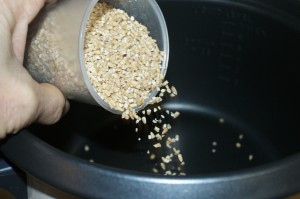
Steel cut oats
Wheat berries (kernels) and cracked wheat
Wheat berries are wheat kernels with the hull removed upon processing. They have a tempting nutty flavor.
To make cracked wheat, whole wheat berries are cut in the factory with steel blades. They cook more quickly than wheat berries.
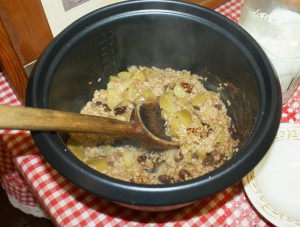
Wheat berries
Bulgur
Bulgur is made by boiling wheat berries, then drying and cracking them. It is a popular food in Middle Eastern countries. It is high in fiber and protein, low in fat, and is an excellent choice for serving in place of rice, working into salads, stuffing vegetables, and filling casseroles and loaves.
The wonderful thing about bulgur is that it is easy to prepare. I simply pour boiling water over the top of the bulgur and allow it to stand for about an hour or two or until the grain is soft and water absorbed. Fluff with a fork and it’s ready to serve or use in any recipe.
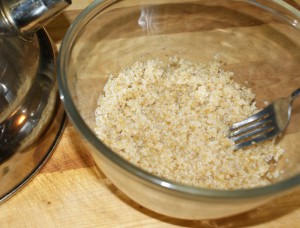
Bulgur is a quick-cooking grain.
Rye kernels and cracked rye (grits)
Rye is a hardy grain that thrives in colder climates. It is a staple in Germany, Russia, and Scandinavian countries. It is a healthy grain since the nutrient-rich covering of bran has not been removed. In Grandma’s old handwritten doctoring journals, she claims eating rye helps prevent gallstones, keeps the heart healthy, and reduces the risk of “sugar diabetes,” as she referred to it in her day. Rye kernels are delicious in porridge or soup.
Cracked rye, or grits, consists of kernels that are broken into small pieces. It is quick cooking and is a nice addition to breads, muffins, and other baked goods.
Buckwheat groats and kasha
Buckwheat, regardless of its name, it not a true member of the wheat family but rather a seed from a flowering plant. It is a perfect pick for those on a gluten-free diet.
Kasha is made up of toasted buckwheat groats. Kasha is available in several forms: whole, cracked, coarse, medium, and fine (also called grits).
Recent studies have indicated that buckwheat helps relieve symptoms of Type II diabetes and lowers high blood pressure.
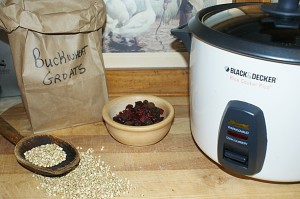
I like to cook buckwheat groats with cranberries.
Quinoa
Quinoa was a staple food of the Incas. They referred to it as their “mother grain.” It is a seed which makes it ideal for those on a gluten-free diet.
It has a flavor slightly similar to sesame and is high in protein and riboflavin, making it a real energy booster. In fact, quinoa is reputed as being beneficial to migraine sufferers. You should always rinse quinoa before cooking to remove possible traces of chemicals.
When quinoa is cooked, it becomes translucent. To cook quinoa, use 2 parts water to 1 part grain. Bring water and quinoa to a boil, reduce heat, then cover and simmer 12-15 minutes. I like to fluff it with a fork and stir in a little butter when serving it as a side dish in place of rice.
There are three different varieties of quinoa: white, red, and black. The most common is white, which has a light, fluffy texture and mild taste. Red quinoa tastes nuttier, and black quinoa is crunchier. Sometimes they are sold as a blend of the three known as rainbow or tri-color quinoa, but these blends are more costly.
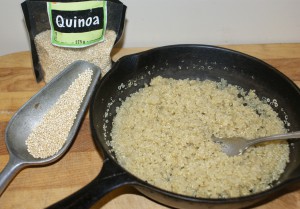
Cooked quinoa is transparent and beautiful on the plate.
Millet groats and cracked millet
Millet is a very small grain which thrives on poor soil and is thought to have originated in Asia. About 20 percent of the land cultivated in China is used for growing millet, and it is the main cereal plant of India. It is gluten-free and considered a very easy grain to digest. The whole grain groats are hulled and sometimes pearled in the same fashion as barley. Cracked millet is processed the same as other cracked grains and is commonly used in dishes similar to traditional couscous.
Millet can be bought popped and eaten as a cold breakfast cereal or snack. Kids love it and some folks have luck at popping it at home themselves, though you can buy it ready-popped.
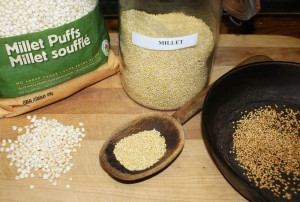
Millet can be eaten popped or cooked normally. Either way is delicious!
Barley (pot, pearl, and purple prairie)
Barley is cultivated in almost every country of the world. It is processed in two basic fashions which produces two types of barley — pot barley and pearl barley. The difference between the two is that pot barley is less polished than pearl barley, meaning it still contains most of its bran.
Barley has a satisfying flavor and texture, and is loaded with healthy nutrients like fiber, selenium, and phosphorus. According to Grandma’s writings, eating lots of barley not only keeps the intestines healthy, but also helps the body to ward off invaders like heart, liver, and stomach diseases and cancers. I seldom make a pot of soup without adding a handful or two of barley to the pot for good measure!
Purple prairie barley is said to have originated in Tibet. It has a deep rich color, but since it usually runs at a higher price, I only buy it in smaller amounts to add to dishes that need a burst of color.
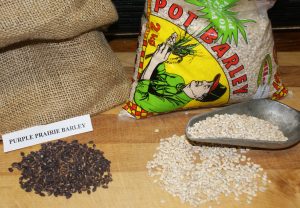
Barley is my top pick to throw in the soup pot.
Amaranth
Like quinoa, amaranth is also a seed which is gluten-free. These tiny, light-colored grains are an ancient food dating all the way back to the Aztecs. They are reputed as being easy on the stomach and good for the intestinal tract. Like millet, they can be toasted or popped, which enhances their flavor for the breakfast bowl.
Since amaranth is a little more costly and a harder grain to come by in my neck of the woods, I usually only buy it in small amounts and use it to top breads or add snap to cookies and homemade crackers. To cook it, use about 1 part grain to 2 parts water or follow package directions for cooking.
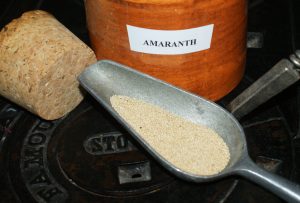
Amaranth is good for the digestive system.
Triticale berries
Triticale is a cross between wheat and rye, developed in the 19th century. Since it is hard to come by and is usually a little more pricy than wheat or rye berries, I tend to use it less often than the more common members of its family.
Spelt berries
Spelt berries have a satisfying chewy texture. They are very much like wheat and rye berries, being loaded with the same health-giving nutrients, but are easier to digest. They belong to the wheat family and thus contain gluten.
Teff
Teff is the smallest grain in the world. It has been a staple of Ethiopian diets for thousands of years. It is loaded with all the goodness of larger grains, but it is not always easy to find in stores.
Rice and corn
There are thousands of varieties of rice from countries all over the world — white, brown, short grain, and long grain. Brown rice, being less processed than many other types of rice, is the healthiest choice.
As far as corn is concerned, it goes without saying that we probably all think of corn as being both a grain and a vegetable. An ear of corn or a dish of corn kernels definitely come to the table as a vegetable offering. Yet popped corn kernels, dried corn kernels, hominy, and grits are grains in every sense of the word.
Recipes
Grains in the porridge bowl
For 4 to 6 servings, put one cup of grain in three cups water (or desired liquid) and cook in chosen method. Serve the hot cereal with milk or cream and drizzle honey or maple syrup over the top.
Variations: Add a diced apple, pear, peach, or other fresh fruit and a sprinkle of ground cinnamon or nutmeg to the pot. I like to spike the porridge with dried fruits such as raisins, currants, cranberries, chopped apricots, dates, figs, or other dried fruit. Add them directly to the cooking pot so they can plump back to life along with the grain.
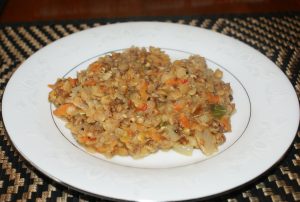
A spicy grain pilaf
Spicy grain pilaf
A pilaf is a fascinating creation, a versatile staple of Middle Eastern countries where the dish originated. Traditionally a pilaf is made with rice but it is equally good, if not better, when made from grains. I like to make pilafs with wheat berries, rye kernels, bulgur, buckwheat, and millet, but you can try any grain or mixture of grains in a pilaf. For endless variety, try adding lentils, split peas, beans, or rice to the pilaf, in which case you might need to decrease the grain measure or increase the water or cooking liquid. You might also add cooked lentils and legumes directly to the finished dish.
This is always a popular side dish at my table. Sometimes when time is running short, I’ll add chopped, cooked leftover meat to the pan for a fast and easy supper.
2 Tbsp. olive oil
1 cup wheat, rye, or spelt berries, buckwheat groats, brown rice, or other grain of choice
1 minced onion
3 cloves of minced garlic
1 cup diced celery
1 cup grated carrot
½ cup minced sweet pepper
3 cups vegetable stock
1 Tbsp. butter
minced parsley for garnish
Heat oil in pan. Add the grain and shake pan until kernels are coated. Add onion and garlic, sauté until onion turns golden. Add celery, carrot, and pepper. I like to add a minced jalapeño pepper, too, but this is optional. Cook about 1 minute before adding the stock. Bring to a boil, reduce heat, then cover and simmer over low heat for 40 minutes or until wheat is soft. Just before serving, stir butter into pilaf — this ensures a lovely buttery flavor. Garnish with parsley. Take note: If your stock isn’t well-seasoned, you can season the pilaf with salt and pepper to suit your taste.
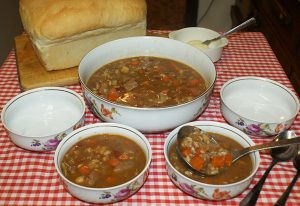
Venison and barley soup makes a hearty meal when served with fresh bread!
Grandma’s venison and barley soup
Like Grandma, my pick of meat for this soup is venison when I am lucky enough to have a stash in my freezer. But when I don’t, I find beef is the next best thing! I like to use pot barley, but pearl barley will do as well. This makes a big tureen of hearty soup — it’s even better as leftovers. Serve with a crusty loaf of homemade bread.
1½ lbs. venison or beef stewing meat, cut into small pieces
1½ cups barley
1 cup dried lima beans
3 Tbsp. margarine or butter
1 Tbsp. olive or vegetable oil
2 chopped onions
3 cloves minced garlic
1 cup diced celery
3 chopped carrots
1 quart canned chopped tomatoes
8 cups water
1 tsp. black pepper
½ tsp. dried marjoram
salt to taste
Put margarine and oil in stock pot, then add onions and garlic and cook until soft. Add meat and cook, stirring often until it loses its color. Add remaining ingredients, except salt. Bring to a boil. Reduce heat, cover and simmer 2½ to 3 hours, at which time the meat and barley will be delightfully tender and the soup will be so fragrant you can smell it a mile away!
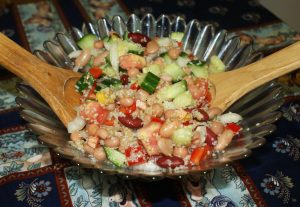
Bulgur and mixed bean salad
Bulgur and mixed bean salad
I adapted this salad from a popular Arab recipe known as tabbouleh which is a perfect salad for toting in the picnic basket, as it stands up exceptionally well. The authentic salad calls for just chickpeas but I find the salad is much more colorful with mixed beans. It is hearty and filling — all you need to accompany it is a crusty loaf of bread, perhaps some cheese, and, of course, fresh fruit of the season.
1 cup bulgur
3 cups boiling water
2 cups cooked or canned mixed beans
1 large chopped firm ripe tomato (for picnic fare I prefer to use about 1 cup of grape tomatoes or halved cherry tomatoes, as they stand up better in the bowl)
1 cup diced English cucumber
¼ cup minced sweet or red onion
¼ cup minced sweet red peppers
fresh chopped parsley
couple of minced basil leaves (original recipe calls for fresh minced mint)
Dressing ingredients
5 Tbsp. virgin olive oil
fresh squeezed juice of 1 lemon (about ¼ cup)
3 cloves mashed garlic
1 tsp. sea salt (or to suit taste)
¼ tsp. pepper
Mix dressing ingredients together into a small bowl (or a little jar if toting as picnic fare). Shake before using.
Pour boiling water over the bulgur and let stand one hour or until the grain is light and fluffy. Drain and press out excess water. Put into salad bowl and add remaining ingredients. Chill. Pour dressing over salad and toss upon serving.
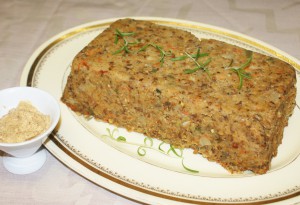
A buckwheat and lentil loaf garnished with fresh rosemary
Buckwheat and lentil loaf
This is a tasty meatless supper dish. Be sure to try it with other grains, too, and different kinds of lentils or split peas for endless variety. Makes a large 9×5-inch loaf.
1 cup buckwheat groats or kasha
1 cup red lentils
3 Tbsp. margarine or cooking oil
1 minced onion
3 cloves minced garlic
1 cup grated carrot
¼ cup minced sweet pepper
1 quart (or about 4 cups) chicken or vegetable stock
few chopped fresh basil leaves
½ tsp. ground coriander
¼ tsp. ground cumin
salt and pepper, to taste
1 lightly-beaten egg
1 cup (more or less) seasoned bread or cracker crumbs
sunflower seeds (optional)
Heat oil in large saucepan. Sauté onion, garlic, carrot, and pepper until soft. Add buckwheat, lentils, stock, and seasonings. Bring to a boil. Cover, reduce heat, and simmer until buckwheat is tender and all the liquid is absorbed, adding more liquid if needed. When cooked, leave off lid and allow steam to escape while cooling. Add egg and enough bread crumbs to bind and achieve a “meatloaf” texture. Turn mixture into a greased loaf pan. Place a piece of waxed paper over top and press the loaf firmly into the pan. This produces a loaf that will slice nicely on the table. Set in fridge and chill until baking time. Bake in preheated 375° F oven for 35 to 40 minutes. Cool slightly before turning out of pan and slicing. It goes great with stone-ground mustard for dabbing on top and buttered green peas on the side.

Millet loaf makes a tasty breakfast or a sweet treat.
Millet morning loaf
This is sometimes known as “mush” and it can be made out of any smaller grain. But I think “loaf” sounds much more appetizing! It makes a wonderful breakfast dish or can be served as dessert to top off a weeknight supper. It makes a small 6½x4x2-inch loaf, yielding 8 to 10 slices. Since this is always such a hit at my breakfast table, I make two loaves and save the second in the fridge for a busy morning. It’ll keep up to two weeks. You could also make one large loaf by doubling the recipe, if desired, in which case the slices would be larger and would dish up more servings.
1 cup millet
3 cups water
flour for dredging
oil for frying
cinnamon sugar for sprinkling (mix 5 Tbsp. sugar with 1 tsp. ground cinnamon)
Bring water and millet to a boil. Reduce heat, cover, and simmer over low heat for 20 minutes or until millet is soft and liquid absorbed. Cool. Turn into greased loaf pan, then cover and chill for several hours or overnight. Turn loaf out of pan and slice. Dust slices lightly with flour and fry in hot oil until crisp and golden on both sides. Sprinkle cinnamon sugar over the top, then flip once, allowing the sugar to melt. Serve hot with butter and maple syrup, if desired. Berries go well sprinkled over the top.
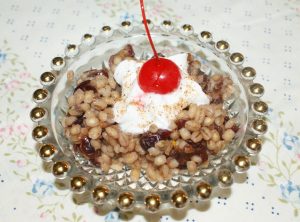
Grain pudding with a cherry on top
Creamy grain pudding
Hearty, filling grain puddings make excellent desserts to follow any light type of supper such as soup or salad. Try this recipe with any grain and any dried fruit you fancy. Serve with a dollop of whipped cream or ice cream on top for special flair.
A little tip — if you have a family heirloom recipe for old-fashioned baked rice pudding, update it by using a grain in place of rice for a refreshing change of pace!
1 cup barley or other grain of choice
3 cups water
2½ cups milk, divided
½ cup maple syrup, honey, or brown sugar
1 tsp. grated nutmeg
1 cup dried fruit (raisins, currants, blueberries, or cranberries)
1 tsp. grated orange zest
1 large egg
1 tsp. maple (or vanilla) extract
Put barley and water in saucepan, bring to a boil, reduce heat, then cover and simmer until barley is tender and water absorbed. Stir in two cups of the milk, syrup, nutmeg, raisins, and zest. Bring to boil, reduce heat, and simmer covered for 10 minutes, stirring frequently. Remove the lid, then continue cooking and stirring until the mixture looks curdled. Whisk egg into remaining milk and add it to the barley. Cook, stirring constantly, until thick and creamy. Remove from heat, stir in maple extract. Serve warm or cold.
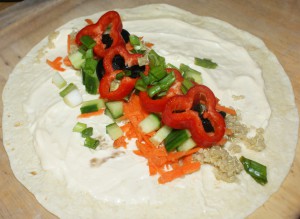
Quinoa lunch wraps are quick and delicious.
Super fast quinoa lunch wraps
This makes four large wraps but you can cut the recipe in half, if you wish. Because these are such a big hit with my kids I often cook four cups of quinoa in one shot and keep it in a covered dish in the fridge ready for use whenever the craving strikes. It’ll save up to a week. There’s no measure for the fresh vegetables — use however much you wish of whichever tickles your fancy!
4 large tortillas (homemade or store-bought)
4 Tbsp. mayonnaise or hummus
1 cup cooked quinoa
grated carrot
diced cucumber
chopped pitted black olives
minced green onions
diced tomato
sweet red pepper rings
minced chile or jalapeño peppers
shredded lettuce, spinach, dandelion, or other greens of the season
Place tortillas on countertop. Spread with the mayo or hummus. Spoon quinoa down the center of the wrap. Top with remaining ingredients. Roll up, slice in half, and enjoy.
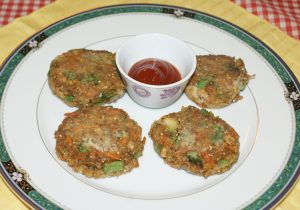
Quinoa patties go well with ketchup.
Quinoa supper patties
These are ever-so-good! They are fast and easy to make. Makes four patties.
1 cup cooked quinoa
¼ cup toasted millet or amaranth (this adds a little crunch)
¼ cup grated carrot
4 minced green onions
1 Tbsp. minced sweet or hot peppers
1½ Tbsp. soy sauce
1 egg
½ tsp. black pepper
seasoned bread crumbs
flour for dredging
oil for frying
Mix all ingredients, except the last three. Add enough bread crumbs to bind the mixture together — how much depends on how moist or dry the quinoa is upon cooking. With lightly-floured hands, form the mixture into patties. Chill until firm. Dredge patties in flour and fry in hot oil until crispy and golden on both sides. Drain on absorbent paper before serving.
Brown rice risotto
From Italy comes the risotto creation — a versatile rice dish. You can add almost anything to a risotto — cooked seafood, chopped meat and poultry, ham, bacon, beans, or any vegetable the garden is producing.
3 Tbsp. olive oil
1 diced onion
3 cloves minced garlic
1 cup chopped mushrooms
2 cups brown rice
1 cup white cooking wine
1 quart chicken or beef stock
¼ cup grated Parmesan cheese
salt and pepper to taste
Heat oil in large skillet, then sauté onion until soft. Add garlic, mushrooms, and rice, stirring until rice is coated in the oil. Add the wine and cook 1 minute. Add 1 cup of stock at a time and allow it to boil down uncovered before adding the next cupful. Continue adding stock in this manner until the rice is tender and the last addition has evaporated. Stir in the Parmesan and season with salt and pepper.
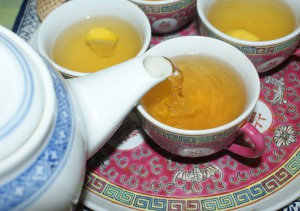
Roasted barley tea is a great picker-upper.
A cup of grain tea
When I was kid, Grandma made grain teas often, especially in the winter to treat cold and flu. Barley was her number one pick for the teapot, but any grain or mixture of grains can be used for a tasty cup of brew
I always divvy up the dregs into the cups when the pot is empty and spoon them up for good measure. The steeped barley is wonderfully chewy.
If you want a good coffee substitute, roast barley, wheat, or rye berries until they are dark brown, then cool, grind, and roast again. Use in place of coffee in amounts to suit taste. Or mix with regular ground coffee to stretch it further and cut down on the caffeine
Heat a small cast iron skillet until a drop of water sizzles and skits across the bottom of the pan. Scatter 3 to 4 tablespoons of barley (pot barley is best for this particular recipe) or other grain into the pan. Dry roast, stirring with a wooden spoon and shaking the pan throughout the process, until it toasts to a golden brown
Once the grain is toasted, empty into the teapot and steep until barley sinks to the bottom of the pot. A little honey and lemon complements this tea very nicely. It’s a soothing hot drink for cold weather and, when served over ice in a pitcher, makes a refreshing summer cooler.
For a super quick cup of broth, add a couple crushed dried shiitake mushrooms to the teapot and season the tea before pouring with a few drops of soy sauce, a drop of sesame oil or hot chile oil, a pinch of black pepper, and enough celery salt to taste.

